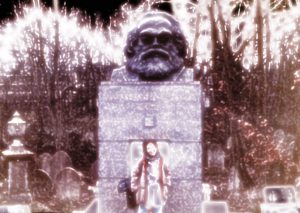You have no items in your cart. Want to get some nice things?
Go shopping
 That grey December day, we walked into the cemetery. You told me that Marx’s tomb was there. You said we just needed to explore.
That grey December day, we walked into the cemetery. You told me that Marx’s tomb was there. You said we just needed to explore.
You were staying with my ex-lover’s ex-lover who used to phone late at night. I could hear him tell her, yes, I was there, and no, please don’t do that. He’d say, I do care, and I don’t want you to hurt yourself. In London, she was more predictable, happy even. She’d moved to Highgate with her new husband. They lived right near the cemetery.
We wandered down the paths, eyed the tombstones and looked up at the mausoleums. You told me about your Statue of Liberty paintings, what the curator did when he read the inscription you’d written across the bottom: ‘Any atrocity is okay as long as you have a mermaid statue.’ Painfully obvious, he’d muttered under his breath.
That was the year that the renovation of Liberty was completed, the statue re-opened, the centennial celebration underway. They’d removed asbestos from the inside of the statue, repaired holes in its copper skin, replaced the torch.
Secret arms sales to Iran are uncovered that year, secret profits funnelled to paramilitaries referred to as Contras in Nicaragua. The CIA’s ‘Freedom Fighter’s Manual’ tells Nicaraguans how to ‘paralyze the military-industrial complex of the traitorous Marxist state without having to use special tools.’ Amnesty publishes its report about Contra war crimes against civilians.
It was your first time in London, out of America, and goodbye to all that. We walked past wind-beaten tombstones, down the muddy trails, over tangles of weeds. Then we came to Marx’s tomb, the ostentatious marble bust put up by the British Communist Party. We burst out laughing. ‘The philosophers have only interpreted the world,’ the inscription read. ‘The point, however, is to change it.’
A mistranslation, I’ll later learn. There was no ‘however’ in the original quote, no contradiction between interpreting and changing.
You photographed me standing beneath Marx’s bust, his worried face above me as I grinned, hands stuffed into the pockets of my parka, kafiyah wrapped around my neck. Then I photographed you with your feet spread, trying to straddle dry ground in all the mud. I still have the snapshots, taken before there were digital cameras- when we sent the film off with no idea of how they would come out.

About Linda Mannheim
Linda Mannheim's most recent book is Above Sugar Hill (Influx Press), a stories of a one time New York City landmark that became known for its high homicide rate and heroine trade. Eimear McBride has said: “Mannheim’s restive tales of her desiccated stretch of New York provoke and abide like a slap.” Linda’s story ‘Trigger’ about a farmer on military during the dying days of Apartheid, was selected as a Kindle Single. Linda’s work has recently appeared in 3:AM Magazine, Catapult Story, and Alfred Hitchcock's Mystery Magazine. She lives in London.




